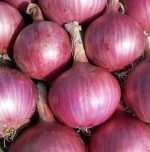Onion prices in India: A rollercoaster ride for consumers

The price of onions in India has once again taken a tumultuous ride, causing distress among both farmers and consumers.
Just six months ago, the cost of this essential kitchen staple ranged from ₹5 to ₹10 per kilogram.
However, today, onion prices have surged to an astounding ₹70, 80, 90, and even ₹100 per kilogram, with predictions that they could soar to ₹150 per kilogram shortly.
The baffling fluctuation in onion prices has raised questions about its underlying causes.
Two primary explanations emerge, a substantial surge in demand coupled with a shortage of supply and the significant increase in prices over the last few days.
Market experts are forecasting that onion prices could reach the ₹150-per-kilogram mark by November.
While demand and supply imbalances are typically the culprits behind such fluctuations, it’s worth noting that India harvests onions twice a year.
These harvests occur during the Rabi season and the Kharif season, ensuring a continuous supply of onions throughout the year.
However, one of the major factors contributing to price volatility is that Indian farmers often opt to sell their onions in international markets to capitalize on higher prices. This leads to a domestic supply shortage.
To curb this practice, the Indian government has introduced a 40% export tax on onions, a significant shift from the absence of export taxes in the past.
Additionally, the government has set a Minimum Export Price (MEP) of ₹66,730 per tonne for onion exports.
This MEP serves as a floor price, ensuring that no onion trader can export their produce at a price lower than this until December 31st.
Furthermore, to stabilize domestic onion prices, the government has made available 2.5 lakh tonnes of onions from the buffer stock of the National Agricultural Cooperative Marketing Federation of India (Nafed) in the local market.
These onions are being sold at a rate ranging from ₹25 to ₹30 per kilogram, providing some relief to consumers.
The onion price rollercoaster in India can be attributed to a complex interplay of factors.
These include the decisions of farmers to export to international markets, government policies like export taxes and MEPs, and seasonal fluctuations in supply.
As consumers eagerly await price stabilization, the government’s interventions aim to ensure that the essential vegetable remains accessible to all.
Image from Pxhere (Free for commercial use / CC0 Public Domain)
You may also like
Image Reference: https://pxhere.com/en/photo/623194
Recent Posts
- Bihar youth builds electric jeep that runs 100 km on a single chargeMurshid previously worked at different mechanic shops after completing his education.
- Delhi’s EV policy 2.0: Incentives, bans & a push for cleaner mobilityThis incentive is meant to encourage people to retrofit existing vehicles instead of scrapping them.
- Books without barriersSakthivel’s mission extends beyond mere convenience.
- Bihar youth builds electric jeep that runs 100 km on a single charge
What’s new at WeRIndia.com
News from 700+ sources
-
Ashika Investment Managers receives SEBI approval for data-driven SmartAlpha Fund
-
Jacob Bethell Scripts History, Becomes Second Youngest To Score Ashes Ton In 21st Century
-
The Mutual Fund Advisor: FD vs Mutual Funds – you are asking the wrong question!
-
Shraddha Kapoor has a playful reply to fan curious about her marriage plans
-
Bandra Bay: Mumbais new waterfront micro-market set to challenge Worlis luxury crown
-
Citi, JPMorgan opt out of $1.4 billion SBI Funds IPO on low fees: Report
-
WeRIndia – A News Aggregator
Visit werindia.com for all types of National | Business | World | Politics | Entertainment | Health related news and much more..










Leave a Reply